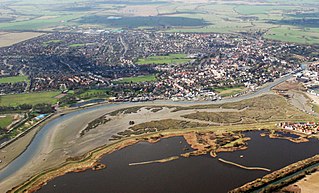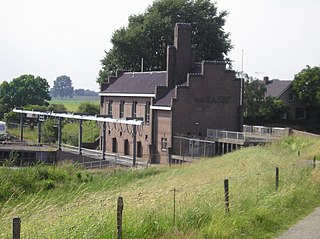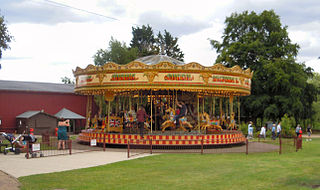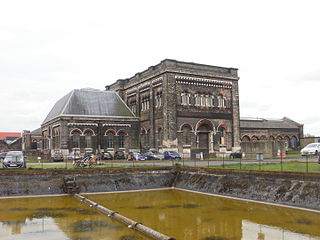
Maldon is a town and civil parish on the Blackwater estuary in Essex, England. It is the seat of the Maldon District and starting point of the Chelmer and Blackwater Navigation. It is known for Maldon Sea Salt which is produced in the area.

The Abbey Pumping Station is a museum of science and technology in Leicester, England, on Corporation Road, next to the National Space Centre. With four working steam-powered beam engines from its time as a sewage pumping station, it also houses exhibits for transport, public health, light and optics, toys and civil engineering.

Pumping stations, also called pumphouses in situations such as drilled wells and drinking water, are facilities containing pumps and equipment for pumping fluids from one place to another. They are used for a variety of infrastructure systems, such as the supply of water to canals, the drainage of low-lying land, and the removal of sewage to processing sites. A pumping station is an integral part of a pumped-storage hydroelectricity installation.

The River Blackwater is a river in Essex, England. It rises as the River Pant in the northwest of the county, just east of Saffron Walden, and flows in a generally southeast direction to Bocking, near Braintree, via Great Sampford and Great Bardfield. At Bocking, it becomes the River Blackwater, and veers east to flow past Bradwell Juxta Coggeshall and Coggeshall. It then veers south, flowing past Kelvedon and Witham, before reaching Maldon. There, it veers east again and empties into the Blackwater Estuary, which in turn meets the North Sea at Mersea Island.

Bressingham Steam & Gardens is a steam museum and gardens located at Bressingham, west of Diss in Norfolk, England. The site has several narrow gauge rail lines and a number of types of steam engines and vehicles in its collection and is also the home of a Dad's Army exhibition.

The Crossness Pumping Station is a former sewage pumping station designed by the Metropolitan Board of Works's chief engineer Sir Joseph Bazalgette and architect Charles Henry Driver. It is located at Crossness Sewage Treatment Works, at the eastern end of the Southern Outfall Sewer and the Ridgeway path in the London Borough of Bexley. Constructed between 1859 and 1865 by William Webster, as part of Bazalgette's redevelopment of the London sewerage system, it features spectacular ornamental cast ironwork, that Nikolaus Pevsner described as "a masterpiece of engineering – a Victorian cathedral of ironwork".

The Kempton Park steam engines are two large triple-expansion steam engines, dating from 1926–1929, at the Kempton Park Waterworks in south-west London. They were ordered by the Metropolitan Water Board and manufactured by Worthington-Simpson in Newark-On-Trent.

London Museum of Water & Steam is an independent museum founded in 1975 as the Kew Bridge Steam Museum. It was rebranded in early 2014 following a major investment project.

Papplewick Pumping Station, situated in open agricultural land approximately 3 miles (4.8 km) by road from the Nottinghamshire village of Papplewick, was built by Nottingham Corporation Water Department between 1881 and 1884 to pump water from the Bunter sandstone to provide drinking water to the City of Nottingham, in England. Two beam engines, supplied with steam by six Lancashire boilers, were housed in Gothic Revival buildings. Apart from changes to the boiler grates, the equipment remained in its original form until the station was decommissioned in 1969, when it was replaced by four submersible electric pumps.

The River Chelmer flows entirely through the county of Essex, England; it runs 40 miles (64 km) from the north-west of the county through Chelmsford to the River Blackwater, near Maldon.

Merryweather & Sons of Clapham, later Greenwich, London, were builders of steam fire engines and steam tram engines.
Langford is a village at the west end of the Dengie peninsula close to Maldon in the English county of Essex. It is part of the Wickham Bishops and Woodham ward of the Maldon district.

Walka Water Works is a heritage-listed 19th-century pumping station at 55 Scobies Lane, Oakhampton Heights, City of Maitland, New South Wales, Australia. Originally built in 1887 to supply water to Newcastle and the lower Hunter Valley, it has since been restored and preserved and is part of Maitland City Council's Walka Recreation and Wildlife Reserve. It was added to the New South Wales State Heritage Register on 2 April 1999.

Brede Waterworks is a waterworks at Brede, East Sussex, England. It was built to supply Hastings with drinking water. The waterworks still houses two of the three stationary steam engines that were used to pump water from Brede to reservoirs at Fairlight and Baldslow.

A blowing engine is a large stationary steam engine or internal combustion engine directly coupled to air pumping cylinders. They deliver a very large quantity of air at a pressure lower than an air compressor, but greater than a centrifugal fan.

The British Engineerium is an engineering and steam power museum in Hove, East Sussex. It is housed in the Goldstone Pumping Station, a set of High Victorian Gothic buildings started in 1866. The Goldstone Pumping Station supplied water to the local area for more than a century before it was converted to its present use. The site has been closed to the public since 2006, and in March 2018 the entire complex was put up for sale.

Cricklewood Pumping Station was built in 1905 to supply water to London's north west suburbs. It is situated at the eastern extremity of Gladstone Park, Cricklewood and is a locally listed building.

The Nottingham Industrial Museum is a volunteer-run museum situated in part of the 17th-century stables block of Wollaton Hall, located in a suburb of the city of Nottingham. The museum won the Nottinghamshire Heritage Site of the Year Award 2012, a local accolade issued by Experience Nottinghamshire. The Museum collection closed in 2009 after Nottingham City Council withdrew funding, but has since reopened at weekends and bank holidays, helped by a £91,000 government grant, and run by volunteers. The museum contains a display of local textiles machinery, transport, telecommunications, mining and engineering technology. There is a display of cycles, motorcycles, and motor cars. There are examples of significant lace-making machinery. It also houses an operational beam engine, from the Basford, Nottingham pumping station.
Essex and Suffolk Water is a water supply company in the United Kingdom. It operates in two geographically distinct areas, one serving parts of Norfolk and Suffolk, and the other serving parts of Essex and Greater London. The total population served is 1.8 million. Essex and Suffolk is a 'water only' supplier, with sewerage services provided by Anglian Water and Thames Water within its areas of supply. It is part of the Northumbrian Water Group.

Twyford Waterworks is a preserved pumping station and waterworks situated close to the village of Twyford and the city of Winchester in Hampshire, England. It is a scheduled monument and now operates as a museum. The site is leased by the Twyford Waterworks Trust and is open on selected days during the year.




















